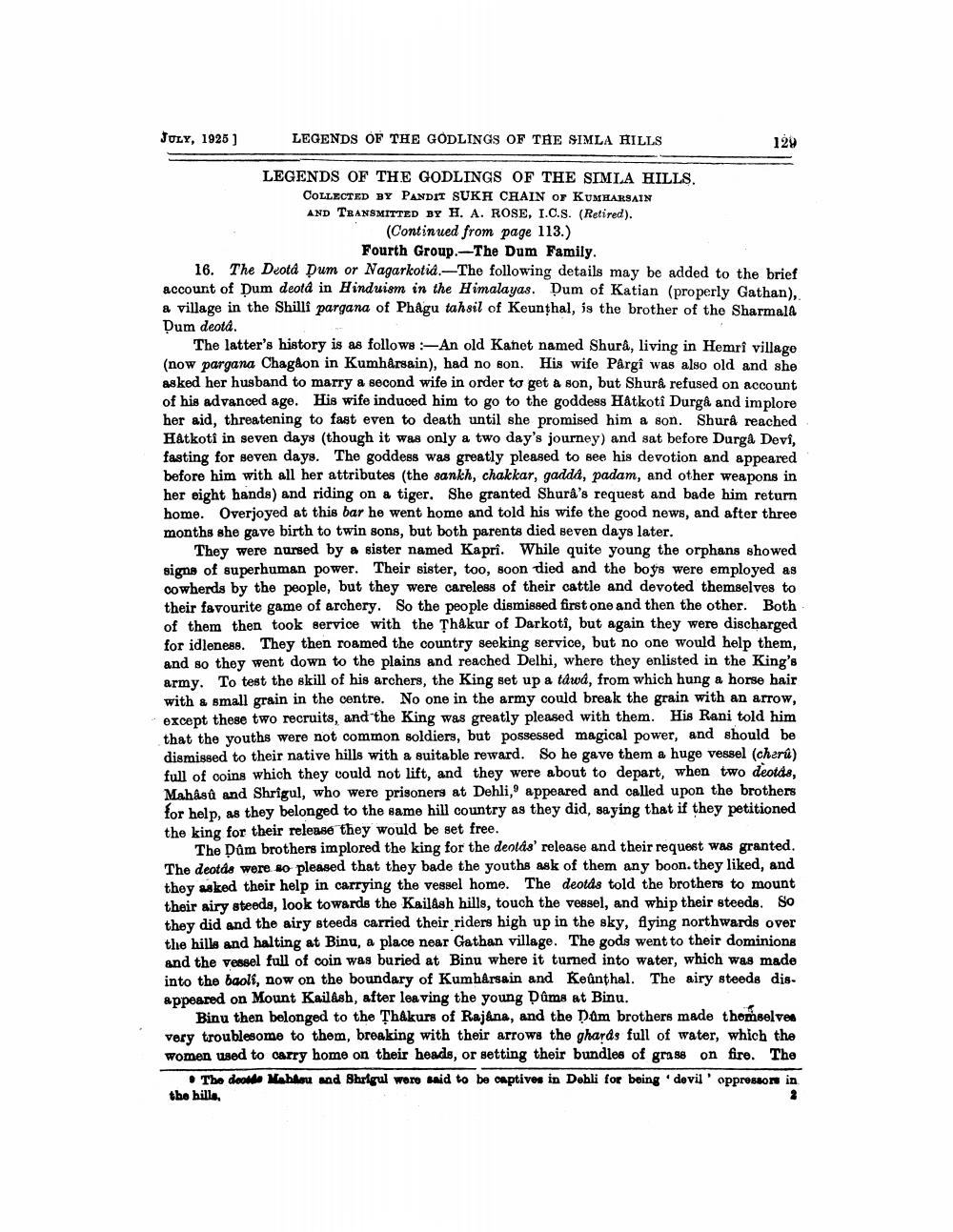________________
JULY, 1925)
LEGENDS OF THE GODLINGS OF THE SIMLA HILLS
LEGENDS OF THE GODLINGS OF THE SIMLA HILLS.
COLLECTED BY PANDIT SUKH CHAIN OF KUMHARSAIN AND TRANSMITTED BY H. A. ROSE, I.C.S. (Retired).
(Continued from page 113.)
Fourth Group.-The Dum Family. 16. The Deota Dum or Nagarkotid.-The following details may be added to the brief account of Dum deotá in Hinduism in the Himalayas. Dum of Katian (properly Gathan), a village in the Shilli pargana of Phågu tahsil of Keunthal, is the brother of the Sharmala Dum deota.
The latter's history is as follows An old Kanet named Shurâ, living in Hemri village (now pargana Chagaon in Kumhårsain), had no son. His wife Pargi was also old and she asked her husband to marry a second wife in order to get a son, but Shurâ refused on account of his advanced age. His wife induced him to go to the goddess Hátkoti Durgå and implore her aid, threatening to fast even to death until she promised him a son. Shurà reached Hatkoti in seven days (though it was only a two day's journey) and sat before Durga Devi, fasting for seven days. The goddess was greatly pleased to see his devotion and appeared before him with all her attributes (the sankh, chakkar, gadda, padam, and other weapons in her eight hands) and riding on a tiger. She granted Shurâ's request and bade him return home. Overjoyed at this bar he went home and told his wife the good news, and after three months she gave birth to twin sons, but both parents died seven days later.
They were nursed by a sister named Kaprî. While quite young the orphans showed signs of superhuman power. Their sister, too, soon died and the boys were employed as cowherds by the people, but they were careless of their cattle and devoted themselves to their favourite game of archery. So the people dismissed first one and then the other. Both of them then took service with the Thakur of Darkoti, but again they were discharged for idleness. They then roamed the country seeking service, but no one would help them, and so they went down to the plains and reached Delhi, where they enlisted in the King's army. To test the skill of his archers, the King set up a tawa, from which hung a horse hair with a small grain in the centre. No one in the army could break the grain with an arrow, except these two recruits, and the King was greatly pleased with them. His Rani told him that the youths were not common soldiers, but possessed magical power, and should be dismissed to their native hills with a suitable reward. So he gave them a huge vessel (charú) full of coins which they could not lift, and they were about to depart, when two deotda, Mahasů and Shrigul, who were prisoners at Dehli, appeared and called upon the brothers for help, as they belonged to the same hill country as they did, saying that if they petitioned the king for their release they would be set free.
The Dâm brothers implored the king for the deoids' release and their request was granted. The deotds were so pleased that they bade the youths ask of them any boon. they liked, and they asked their help in carrying the vessel home. The deotds told the brothers to mount their airy steeds, look towards the Kailash hills, touch the vessel, and whip their steeds. So they did and the airy steeds carried their riders high up in the sky, flying northwards over the hills and halting at Binu, a place near Gathan village. The gods went to their dominions and the vessel full of coin was buried at Binu where it turned into water, which was made into the baoli, now on the boundary of Kumharsain and Keunthal. The airy steeds disappeared on Mount Kailash, after leaving the young Dums at Binu.
Binu then belonged to the Thakurs of Rajana, and the Dom brothers made thomselven very troublesome to them, breaking with their arrows the ghards full of water, which the women used to carry home on their heads, or setting their bundles of grass on fire. The
The doorde Mahlon and Shrigul were said to be captives in Debli for being devil'oppresson in the hill,




